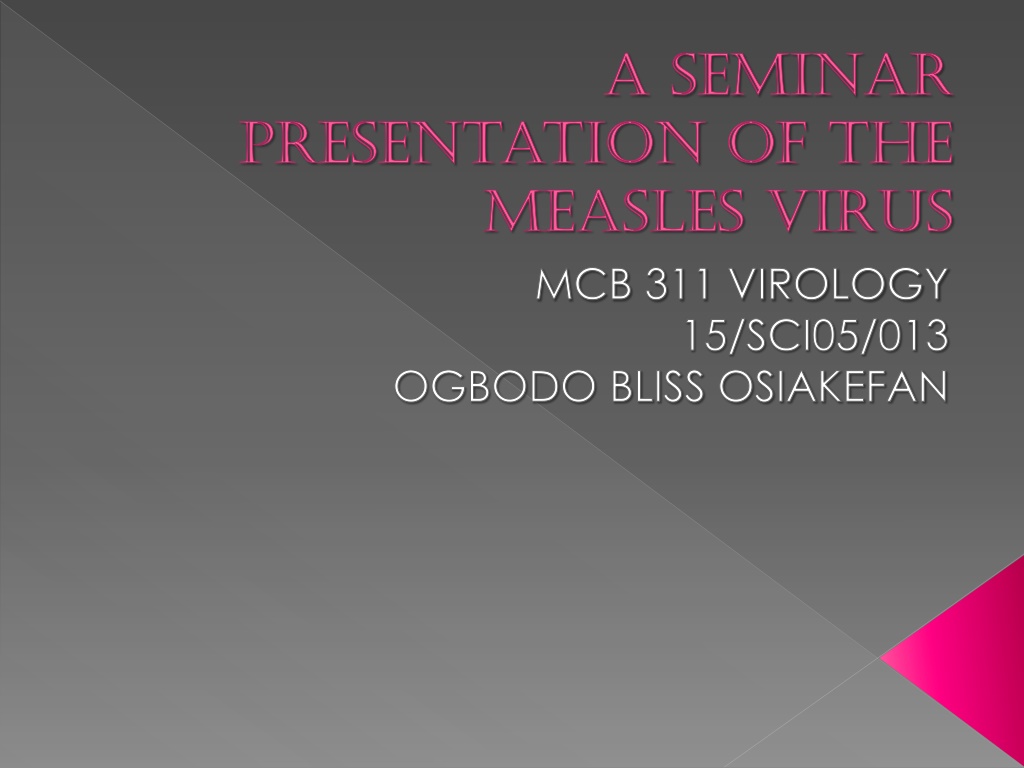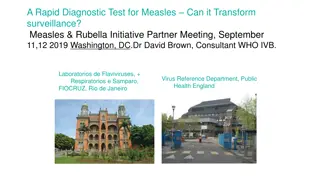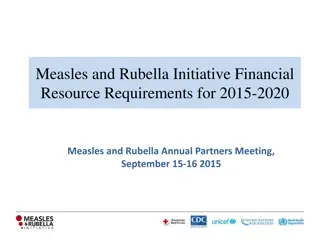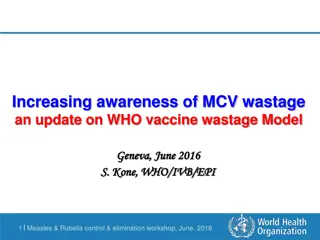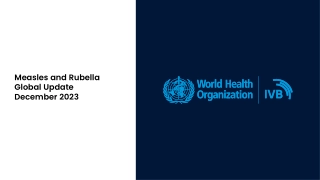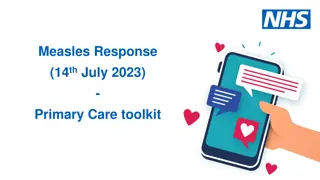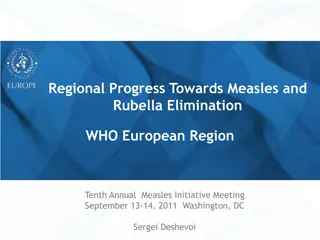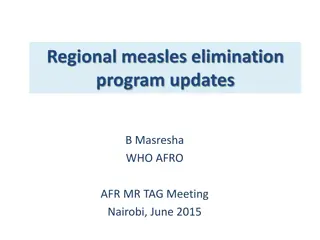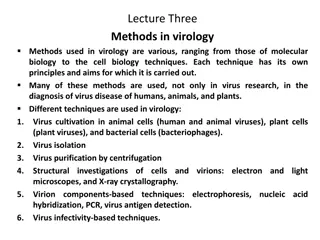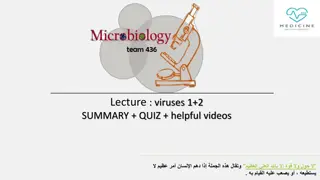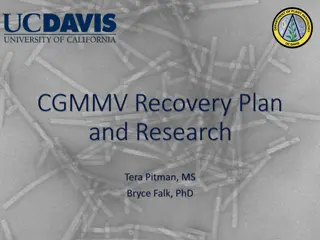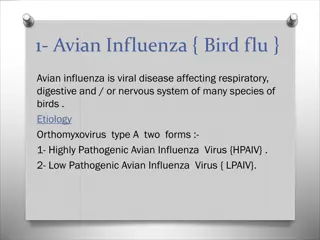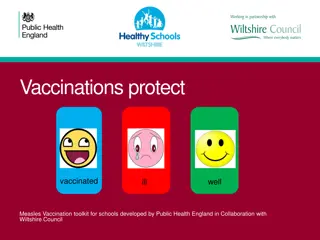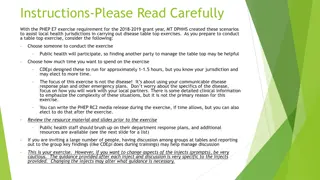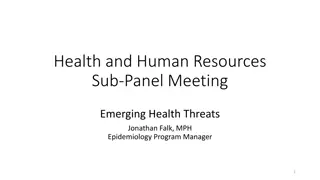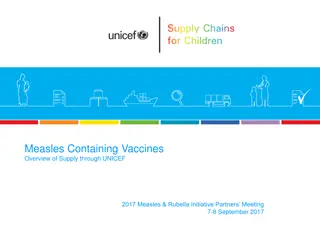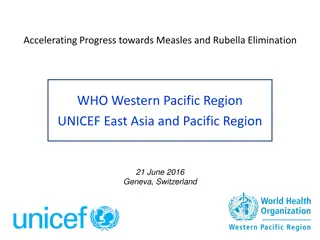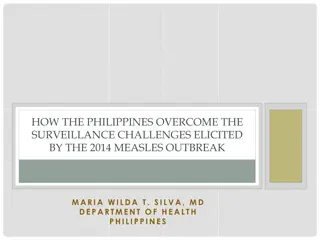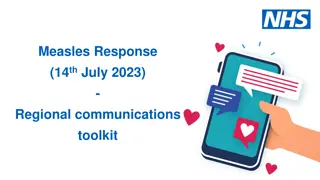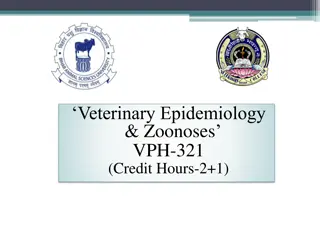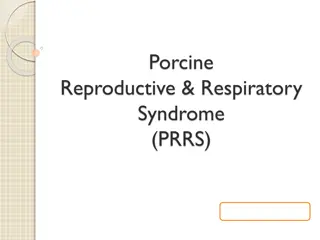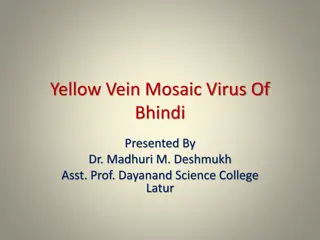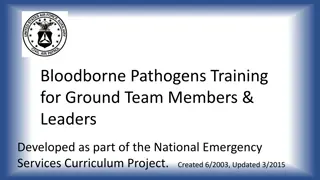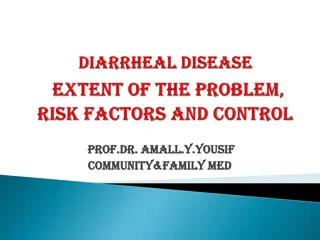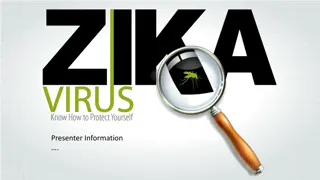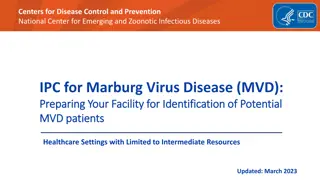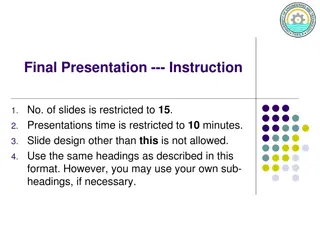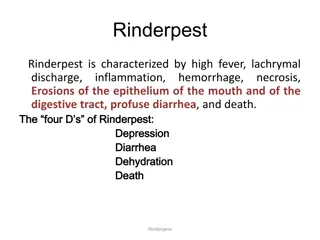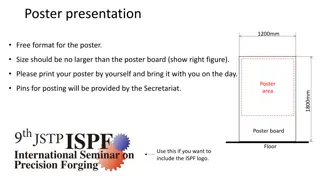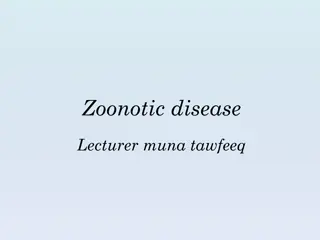Understanding Measles Virus: A Comprehensive Seminar Presentation
The measles virus, also known as rubeola or morbilli virus, is a highly contagious infection that primarily affects the respiratory system. This presentation delves into the classification, characteristics, and pathogenesis of the virus, shedding light on its structure, transmission, and impact on public health. By exploring the two types of measles and their distinct features, this seminar provides valuable insights into the prevention and management of this endemic disease.
Download Presentation

Please find below an Image/Link to download the presentation.
The content on the website is provided AS IS for your information and personal use only. It may not be sold, licensed, or shared on other websites without obtaining consent from the author. Download presentation by click this link. If you encounter any issues during the download, it is possible that the publisher has removed the file from their server.
E N D
Presentation Transcript
A seminar presentation of the measles virus MCB 311 VIROLOGY 15/SCI05/013 OGBODO BLISS OSIAKEFAN
INTRODUCTION The measles virus is also known as rubeola or morbilli virus. It s an endemic disease(meaning continually present in a community, and many people develop generally affects children and can occur in other age groups. However, if measles enters an area where the people have never been exposed, the result can be devastating. It s a spherical , non segmented single stranded RNA virus . it is resistance) ,it
What is measles? It s a viral infection of respiratory system with distinct red spots followed by a rash on the skin. It s a very contagious disease that can spread through with infected mucus and saliva. An infected person can release the infection into the air when they cough or sneeze. Drinking from an infected person s glass, or sharing eating utensils with an infected person, increases your risk of infection.
Measles virus classification Measles virus(rubeola virus) is a single stranded, negative sense, enveloped( non segmented) RNA virus of the genus morbillivirus within the family paramyxoviridae mononegavirales. The negative viral RNA is complementary to the mRNA and must be converted to a positive RNA by RNA polymerase before translation, therefore, the purified RNA of a negative sense virus is not infectious by itself, as it needs to be converted to a positive sense RNA for replication, it utilizes various complexes of proteins during replication. group v virus i.e. a under the order
This shows the ultra structural appearance of the single virus particle of measles virus, it is 100-200 nm in diameter with a core of single stranded RNA. This was revealed with a thin section micrograph(TEM). transmission electron
There are two membrane envelope proteins that are important in measles pathogenesis, they are the f(fusion) protein, which is responsible for fusion of virus to the host cell membranes, viral penetration, and haemolysis, and the H (haemgglutinin) protein which is responsible for adsorption of virus to cells .
TYPE OF DISEASE Measles is a highly contagious/ infectious viral disease caused by a paramyxovirus. Its an infection that affects the respiratory system. It is airborne( through droplets). There are two types of measles, they are German measles or rubella, which forms rashes on the skin and it lasts about three days and rubeola or regular measles, is the second type that lasts about seven days. Roseola is similar to measles, it forms rashes and comes and goes in 24-48 hours
Fast facts of measles In the 21stcentury scientists have discovered 21 strains of measles. The measles virus can survive on surfaces and in the air for several hours(maximum of 2 hours). Measles is a disease of humans, measles virus is not spread by any other animal species. Gombe state records 15 deaths and 864 suspected cases from measles in 2017. Reports of measles 700years Its 1stdescription is attributed to the Muslim physician IBN RAZI 860-932 who published a book entitled small pox and measles. go back to at least
Fast facts According to UNICEF surveys and WHO report, Nigeria tops the list unvaccinated children from measles with 3.3 million children, followed by India 2.9 million, Pakistan 2.0 million, Indonesia 1.2 million, Ethiopia 0.9 million and Democratic Republic of Congo, DRC with 0.7 million. The measles vaccine has saved 20 million lives since 2000. Measles is so contagious that if one person has it, 90% of the people close to that person who are not immune will also infected. of countries with
A picture of a child infected with measles A picture of an adult infected with measles
Route of infection Measles infection of the respiratory system. The virus can spread through various means: 1. Physical contact with an infected person. 2. Being near infected people if they cough or sneeze. 3. Touching a surface that has infected droplets of mucus and then putting fingers into the mouth, or rubbing the nose or eyes. It is airborne(through droplets). One cannot get measles more than once. After been infected by the virus, he/she is immune for life. is a highly contagious/infectious viral
Pathogenicity As soon as the virus enters the body, it multiples in the back of the throat, lungs and the lymphatic system. It later infects and replicates in the urinary tract, eyes, blood vessels, and the central nervous system. The virus has three consecutive periods: 1. Incubation period: 10-15 days is the incubation period of measles. In those days no sign or symptoms, will appear.
2. Exposure period: the measles rash appears 2-4 days after the initial symptoms and lasts for up to 8 days. Measles typically begins with mild to moderate fever, accompanied with cough, runny nose ,sore throat and red eyes. Small red rash first appears to face then after few days spread to the whole body with high temperature. 3. Communicable period: measles are infectious from starting four appears and ending when the rash has been present for four days . days before the rash
What are the symptoms of measles? Symptoms of measles generally appear within 14 days of exposure to the virus, symptoms include: Cough Fever Red and watery eyes Light sensitivity(photophobia) Muscle aches Runny nose Sore throat Koplik s spots, or very small greyish white spots with bluish white centres in the mouth, insides of cheeks, and throat. A wide spread skin rash. A measles rash, which appears as red, itchy bumps, commonly develops on the head and slowly spreads to other parts of the body.
Complications of measles Complications associated with measles may include: 1. Ear infection(oititis media) 2. Respiratory tract infections, such as laryngitis and bronchitis 3. Miscarriage in pregnant women 4. Severe diarrheal and vomiting 5. Hepatitis 6. Encephalitis 7. Thrombocytopenia 8. Squint and neuritis 9. Heart complications 10. Subacute sclerosing panencephalitis(SSPE) 11. pneumonia
Treatment There medication to treat measles. There are different types of supportive treatment ways for measles: 1. Control fever and relief ibuprofen, acetaminophen or naproxen can help to reduce fever and relief pain and aches. 2. Adequate rest and isolation: infected person should get plenty of rest and stay out of school, workplace, public place at least 4days after the rash first appear. 3. Vitamin A supplements: two dose of vitamin A supplements should be taken 24 hours apart after exposure to measles. Vitamin A helps to nourish children and can help to prevent eye damage and blindness. is no specific treatment, no prescription pain: paracetamol,
4. ORS(oral adequate fluid intake(six to eight glasses of water a day) and to treat dehydration causes by diarrheal or vomiting. 5. Antibiotics: antibiotics prescribed to treat eye and ear infection and pneumonia. 6. Sunglasses, keeping the lights dim or the room darkened may enhance comfort levels, as measles increases sensitivity to light. 7. If there is crustiness around the eyes, gently clean with a damp cloth. re-hydration solution): ensure should be
Prevention Immunizations can help prevent a measles outbreak. There were initially two types of vaccines developed against measles. One was developed from a virus that had been killed, and the other was developed using a live measles virus that was weakened and could no longer cause the disease. Unfortunately, the killed measles virus(KMV) vaccine preventing people from getting the disease, and its use was discontinued in 1967. the live virus vaccine has been modified a number of times to make it safer and today is extremely effective in preventing the disease. The currently used vaccine is a live vaccine. The MMR vaccine is a three in one vaccination that can protect one from measles, mumps, and rubella. Children can receive their first MMR vaccination at 12 months and their second dose between the ages of 4 and 6. adults who have never received an immunization can request the vaccine from their doctor. MMR vaccine has side effects like fever, rash and gland swelling. Rare reports are deafness, seizure, coma, lowered consciousness and brain damage. One can also prevent measles with a dose of immunoglobulin taken within 6 days of contact with an infected person. was not effective in
Control measures People who are not immune should consider the measles vaccine. If one contacts the measles virus, limit interaction with others, i.e. isolation. A child with measles should not return to school until at least 5 days after the rash appears.
Conclusion Measles virus is a virus that uses the lytic cycle to reproduce , it destroys the host after producing as many copies possible. If measles is not properly treated or maintained it could complications and possibly death. Measles can be modified or atypical. lead to serious
THANKS FOR LISTENING
